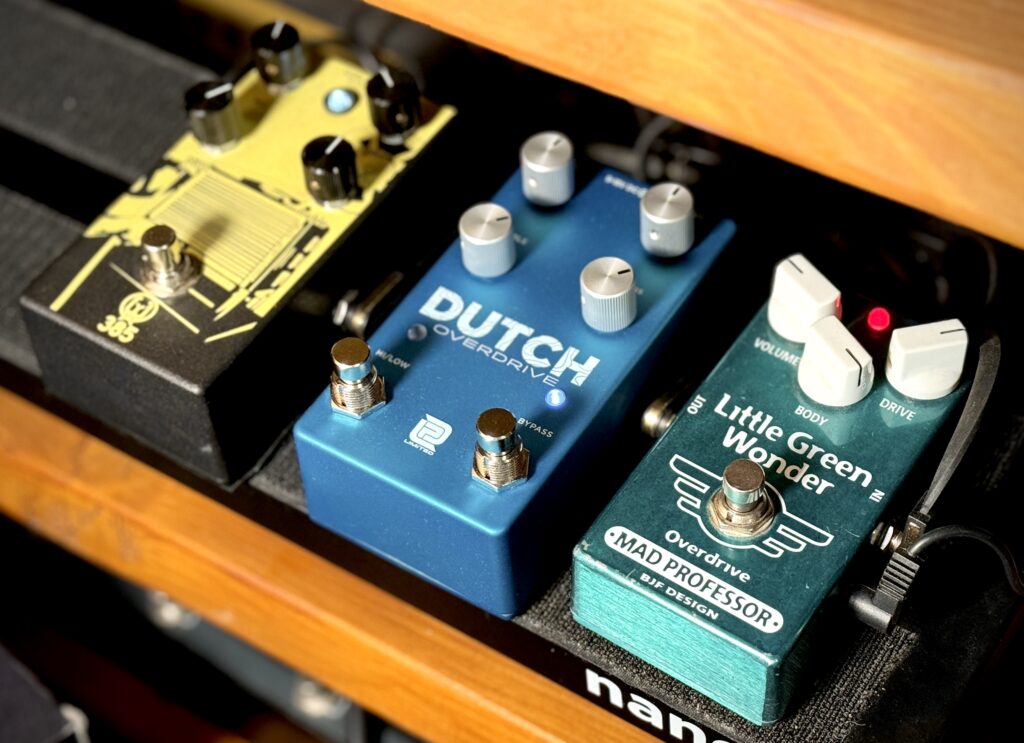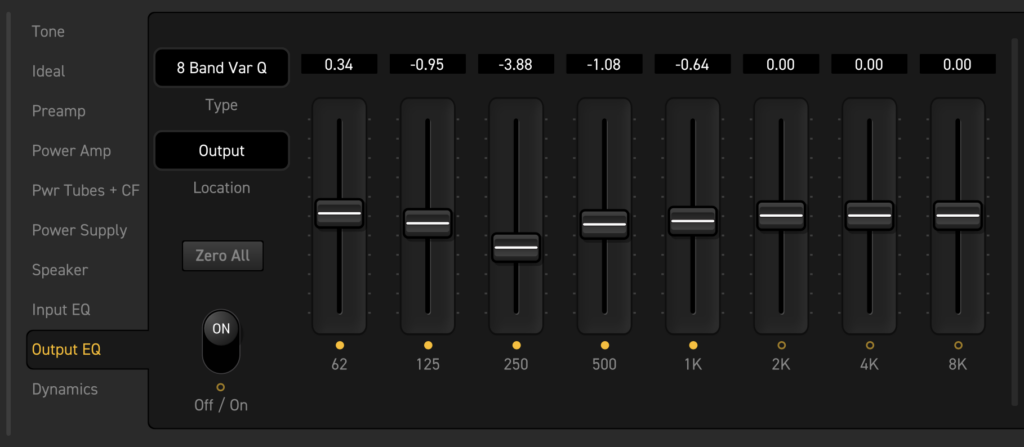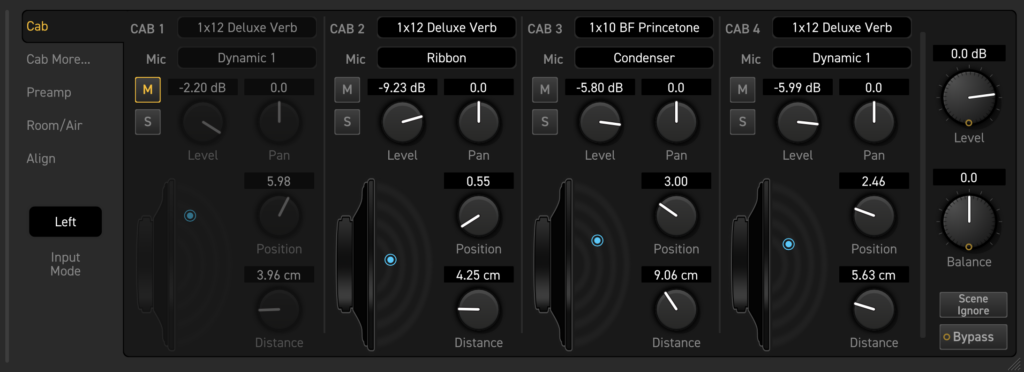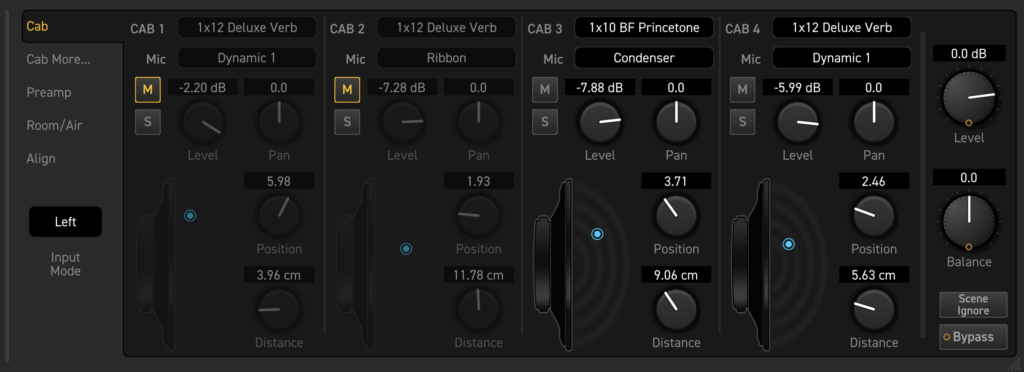This is a second (and lengthy!) look at the LPD Pedals Dutch ’24 that I recently bought.

I’ve already written a First Impressions on the Dutch ’24. In that, I said that I’d briefly tried it as a main overdrive, and was a bit meh about it. (You should definitely go and read that post. I was very happy with how it helped me address the top-end of position 4 on my Strat.)
When used as a main overdrive, I’m finding the Dutch ’24 both incredibly familiar and – at the exact same time! – quite different too.
It’s been bugging me ever since.
So I spent a couple of evenings at the start of the week comparing the Dutch ’24 against other pedals aimed at the blues-rock market.
Along the way, I fell in love with how the Dutch ’24 is its own thing.
Table of Contents
- My Rig Today
- Head-To-Head Comparisons, Podcastage-Style
- Dutch ’24 and the Warm Audio Centavo
- Dutch ’24 and the Marshall Bluesbreaker
- Dutch ’24 and the Wampler Pantheon
- Dutch ’24 and the Wampler Belle
- Dutch ’24 and the Paul Cochrane Timmy v2
- Dutch ’24 and the Lovepedal Amp11 (Black Edition)
- Dutch ’24 and the Analogman King of Tone (Overdrive mode)
- Dutch ’24 and the Ibanez mini-Tubescreamer
- Dutch ’24 and the Mad Professor Little Green Wonder
- Three Contrasting Pedals
- Dialling In A Lower-Gain Crunch
- Final Thoughts
My Rig Today
Today, I’m playing:
- my Les Paul
- into the Axe-FX 3 (just for the tuner – no EQ toys today)
- out to my pedalboard
- back into the Axe-FX 3 (for amp, cab, delay and reverb)
- out to my audio interface
- and into my DAW.
I’m playing my Les Paul on the middle pickup. The neck pickup volume is on 7.5, and tone is on 8. The bridge pickup volume is on 9, and the tone is on 9.5. (And no, I still haven’t changed the strings yet.)
On the pedalboard, every pedal mentioned today is in a separate loop of my trusty Gigrig G2. This ensures that, when a pedal isn’t being used, it is completely out of the signal path and cannot colour the signal in any way.
The Axe-FX 3 is running my 65 Clean pedal platform preset. I’m on Scene 5 (65 4 Most Guitars), with the amp’s Mids control turned up to 6.20. (I will probably make this the default value soon.) The Bass control is sometimes at 6.20, sometimes at 3.20, and occasionally elsewhere. (I’ll make that clear for each demo).
I’ve done no post-processing my DAW at all. I will have level-matched the demos before publishing.
Let’s get into the comparisons.
Head-To-Head Comparisons, Podcastage-Style
In true Podcastage-style, you’re going to hear the Dutch ’24 first as the reference sound, and then the overdrive pedal that I’m comparing it with.
The Dutch ’24 is in Lo-mode, with the Treble around 1 o’clock, the Bass around 11 o’clock, and the Gain around 12 o’clock.
I’ve dialled the Dutch ’24 in to give me a sound that I enjoy playing with my Les Paul. For me, that turned out to be a medium-gain rhythm tone. The pedal’s EQ controls are very powerful; this isn’t the only sound that the Dutch ’24 can do.
For the comparisons, I’ve picked a bunch of overdrive pedals that IMHO also do the blues-rock thing. I’ve dialled each one in to give me a sound that I’d use.
I’ve made no effort to try and make them sound like the Dutch ’24.
I’m far more interested in hearing what options the Dutch ’24 offers, because that’s what makes a pedal interesting to me.
Dutch ’24 and the Warm Audio Centavo
Seeing as I spent a lot of time comparing the Dutch ’24 to a Klon klone in the last blog post, I thought that this would be a good place to start.
I’ve picked the Centavo because I think it sounds absolutely glorious as a main overdrive pedal. The Dutch ’24 does too!
I found that the Dutch ’24 has a colder, more aggressive tone than the Centavo through my rig. I think it’s also got a thicker, more saturated mid-range too, even though the Centavo also overs a nice amount of saturation.
I really like how both pedals emphasise different parts of the mid-range. Maybe they’d go nicely together as complementary guitar tones in a mix?
Dutch ’24 and the Marshall Bluesbreaker
I think it’s hard to beat a Les Paul into a Marshall Bluesbreaker for classic blues-rock tones. It’s a classic sound, and a great baseline to use for these kind of comparisons.
Although they sound similar at first, the more I listen back, the more I’m hearing differences between the two pedals. There’s that extra mid-range saturation from the Dutch ’24 again, and a bit more mud in the low-end. (I’ll come back to that before the end of this blog post.)
I think this demo comparison also does a great job of demonstrating how the top-end of the Dutch ’24 doesn’t seem to extend into the highest frequencies as much as I’m used to. It’s not just that the Bluesbreaker sounds brighter, I think it also sounds more airy too.
If that bothers you, one solution is to add an EQ boost at around 5 kHz. I’ve done that in the Axe-FX 3, and here’s how that sounds, in case you’re interested.
Dutch ’24 and the Wampler Pantheon
When it comes to pedals based on the Bluesbreaker circuit, I think the Wampler Pantheon is one of the very best that there is. The EQ controls make it easier to dial in for different guitars, and the Presence control – when used wisely! – adds a sprinkling of fairy dust that elevates the tone to be something very special indeed.
I’ve definitely dialled in a lot less gain on the Pantheon, compared to the Dutch ’24, but this is where I like to use it.
To my ears, the Pantheon sounds more ‘vintage’ … most of its energy is in the upper-mids. (I think it’s even more vintage-voiced than the Marshall Bluesbreaker tbh!) Side by side like this, I think the Dutch ’24 sounds a little muddy dialled in like this.
I’ll come back and take another look at this before I’m done today.
Dutch ’24 and the Wampler Belle
The Wampler Belle is based on Nashville’s most widely-used pedal, the legendary Nobels ODR-1. If you want a generic overdrive tone to suit most genres, the ODR-1 has to be one of your options to audition.
I just want to take a moment to appreciate how balanced the Belle sounds. It doesn’t have that vintage upper-mids energy, and it doesn’t have a modern mid-scoop going on either. Very nice indeed.
In comparison, I think the Dutch ’24 sounds far more amp-like. Maybe it’s that mid-saturation? The further through these comparisons I get, the more that’s growing on me.
I’m also getting the message, though, that I need to come back later on and dial in some different settings to get the best out of the Dutch ’24.
Dutch ’24 and the Paul Cochrane Timmy v2
I think it’s worth looking at how the Dutch ’24 compares to the legendary Timmy pedal. The Timmy’s a firm favourite for blues-rock tones, and it used to be all over YouTube back when guitar YouTube demos were first breaking onto the scene.
Here, I’m using my Timmy v2, with the toggle switch in the middle position. This is an original Timmy, not the MXR Timmy mini-pedal. If you like what you’re about to hear, the MXR Timmy is a licensed copy that’s far easier to get and sounds pretty much identical. If you do want to buy one from Paul himself, keep an eye on his Reverb shop.
I believe the Timmy is commonly used as a tone-shaping boost for crunchy amps, rather than as the main source of dirt? As you’ll hear, though, it holds up just fine as the main overdrive pedal too.
To my ears, while the two pedals have a different EQ, the Timmy’s getting closer to that lovely Dutch ’24 mid-saturation than anything else I used so far.
Dutch ’24 and the Lovepedal Amp11 (Black Edition)
The Lovepedal Amp11 is another classic overdrive pedal that’s great for blues-rock tones. (No, it isn’t a Timmy.)
I’m using the black edition, a.k.a. the Prymaxe Vintage edition. (Prymaxe Vintage used to be an American gear retailer that Mike Hermans did a lot of great boutique pedal demos for in the early days of guitar YouTube. Mike’s demos are a big reason that I got into modern pedals.)
This version has a slightly different voicing than the original Amp11. I believe this became the standard voicing on all Amp11’s made after this? Certainly my Lovepedal OD11 (which came much later) sounds identical to my Amp11.
Anyway, point is that there are some Amp11’s out there that sound different (I believe they’re the teal-coloured ones?), just in case you’re tempted to pick one up for yourself. Mosky also do a clone that sounds identical to my ears, and the Tone City Durple was very similar in tone when I tried it.
This is the first time I’ve had the Amp11 through the Axe-FX 3 … and I’m sat here asking myself, ‘why?’ Until I ventured into tweed-tone, the Amp11 was my #1 drive pedal on my board. I need to get back to this pedal!
Got to say, though, that I’m also loving that mid-saturation from the Dutch ’24. Again, that whole dual-guitar complementary tone thing is coming to mind. Could be a good pairing to have the Dutch ’24 panned hard left and the Amp11 panned hard right in a recording?
Dutch ’24 and the Analogman King of Tone (Overdrive mode)
Just for completeness … the Analogman King of Tone is the pedal that started the whole craze for Bluesbreaker-circuit pedals. It was one of the original boutique overdrive pedals, and even to this day, people wait years for the opportunity to buy one.
Mine has the high-gain option on both sides. I’m on the red side, which is in the overdrive mode.
I think these two pedals are very different in practice.
The KoT is such a low-gain pedal that I have to crank it to get it into rhythm territory. To my ears, it also shelves off a lot of low-end compared to other pedals – which makes sense for a pedal that’s really designed to boost an amp, rather than be the main overdrive.
No such issues / limitations with the Dutch ’24 though!
One thing I’m taking away from this comparison is just how different the voicings are. The Dutch ’24 is definitely giving me British / Marshall-like tones compared to the strong USA-voicing of the KoT.
Dutch ’24 and the Ibanez mini-Tubescreamer
The Tubescreamer is to Texas blues what the Bluesbreaker is to British blues. And totally not my world at all.
Here, I’m playing the Ibanez TS-mini. I believe this is voiced just like the classic TS-808 version of the Tubescreamer?
Not the same, but definitely the closest yet in these comparisons.
To my ears, the overdrive characteristic is really similar at these settings. Both have that more saturated sound that none of the other pedals have exhibited today.
The EQ sounds slightly different to me. It sounds like the Dutch ’24 is putting out a little less top-end, and a little more low-end. I think there’s a difference in the mid-push from both pedals too, but I don’t really understand the difference that I’m hearing.
Dutch ’24 and the Mad Professor Little Green Wonder
Finally, I’m going with the LGW.
The Mad Professor Little Green Wonder is the Tubescreamer for folks who don’t like Tubescreamers. Designed by legendary pedal designer Björn Juhl, the LGW features a unique ‘Body’ control that acts as both a Treble and Bass control all in one.
I’m running mine with the Body control at around 4 o’clock. This seems to be the sweet spot, offering the most low-end without the top-end turning into a spitting frying pan.
I like this comparison because I think it really highlights how the Dutch ’24 is just EQ’d differently to other blues-rock pedals.
How can I describe it? The energy from the Dutch ’24 seems to be in a different place to the other pedals. It’s as-if the Dutch ’24’s EQ is shifted down the frequencies a bit. Maybe I’m totally wrong about it. That’s just how it feels to me.
Three Contrasting Pedals
Showcasing The Dutch ’24
After I was done recording all of the side-by-side comparisons, I felt that I wanted to put the Dutch ’24 together with two other pedals, to offer a good demonstration of how it contrasts with other blues-rock tones.
I’ve settled on the Walrus Audio 385 and the Mad Professor Little Green Wonder.
The Walrus Audio 385 is a tweedy kind of sound, only it’s not based on any of the usual tweed amp tones. It’s actually a recreation of a circuit found in an old projector unit (the Bell and Howell Filmosound 385 projector) from the late 50’s. I think it’s a good choice for this showcase because it offers a warm sound without becoming muddy.
The Mad Professor Little Green Wonder, designed by legendary pedal designer Björn Juhl, is the Tubescreamer for folks (like me) who don’t like Tubescreamers. It brings a unique Body control that allows some latitude for adjusting how much low-end gets shelved off. I’ve picked it because it offers less of the original Tubescreamer’s mid-range dominance.
Dialling In The Amp For The Dutch ’24
If you’ve listened to any of the previous demos, I had my amp dialled in the way that I would use it with most overdrive pedals. In particular, I had the amp’s Bass control up at 6.20.
When it comes to amp settings, I’m mostly a set-and-forget kind of player. If I’m switching between multiple pedals, I don’t want to be tweaking the amp every time. I’m going to leave the amp where the pedals sound good, and just avoid any pedals that won’t work with whatever amp settings I’m using at the time.
I don’t think it suits the Dutch ’24 to have the Bass control up so high, at least not for me. In many of the side-by-side demos, I felt that the Dutch ’24 just ended up sounding dark and even muddy at times when compared to the other pedal.
So for this three-way showcase, I’m going to dial in my amp to suit the Dutch ’24, and we’ll hear how my chosen pedals also sound with that same amp setting.
All I’ve done is dropped the Bass control on the amp from 6.20 to 3.20. Everything else is the same, and I haven’t changed any of the controls on the Dutch ’24 at all.
The Dutch ’24, Walrus Audio 385 and Mad Professor Little Green Wonder
Here’s how all three pedals sound with the amp dialled in to suit the Dutch ’24.
I think this does a useful job of highlighting how the Dutch ’24 gives me a new option to explore.
It’s thicker, darker, more amp-like and more aggressive-sounding. Rightly or wrongly, the more I listen to it, the more I think it has a Marshall-like voicing. I don’t think it’s a neutral, generic overdrive.
Comparing All Three Pedals At Their Best
Truth be told, I don’t think the other pedals sounded their best when my amp was dialled in for the Dutch ’24. I just took away too much low-end from the 385 and (especially) the LGW.
So let’s try again, and this time I’m changing the amp settings for each pedal in turn.
- For the 385, I’ve set the Bass control at around 4. Any higher, and the low-end can get a bit boomy with my Les Paul in the middle position.
- For the Dutch ’24, I’ve used an EQ to carve out a lot of the low-mids, and then set the amp’s Bass control at 4.5 to balance that out.
- For the Little Green Wonder, I’ve gone back to the original amp settings with the Bass up at 6.
Here’s a screenshot of the EQ carve that I’ve used on the Dutch ’24 demo.

And here’s how all three pedals sound.
Maybe my ears are getting fatigued by this point, but I think all three pedals are now sounding a lot closer to each other. I’m hearing a few differences:
- The 385’s sounding nice and tweedy, with a lovely raspy overdrive character.
- The Dutch ’24 still has the extra saturation and aggressiveness, with more clarity and a very interesting hairy overdrive characteristic.
- The Little Green Wonder sounds a little more laid back.
What do you think? Let me know in the comments below.
Tweaking The Cab Instead of The Amp
Not everyone is a fan of using EQ to carve out the mid-range like that. There’s a good argument that I should be fixing problems closer to the source.
In a purely analogue world, we’d do that by moving the mics around. And we can do that in the Axe-FX 3, by moving the virtual mics around. So that’s what I’ve attempted.
In case you’re interested, here’s a pair of before and after screenshots:


I ended up muting the virtual ribbon mic entirely, and just moving the virtual condenser mic a little further away from the speaker cab to balance everything out so that it wasn’t too bright. I really like the end result, and I’ll probably end up using these settings again for other pedals.
I think that this is a technique that really suits us home-hobbyist players. We’re playing at our leisure, not worrying about tap-dancing on pedals during a live show.
Here’s how the showcase now sounds:
Oh wow. There it is. To my ears, that’s fixed the low-end mud and the high-end roll-off all in one go. The Dutch ’24 is now sounding far more balanced, while still keeping its own character.
That’s the way I’m going to use it in future, with its tailored virtual Cab settings.
Dialling In A Lower-Gain Crunch
Revisiting The Pantheon Side-By-Side Comparison
Before I finish, there’s one last question that I want to answer for myself.
I want to know how the Dutch ’24 sounds as a lower-gain rhythm drive pedal too, like I had the Pantheon dialled in above.
Here’s a reminder of how they both sounded:
Let’s see what happens when I dial back the gain on the Dutch ’24.
Reducing The Gain Reveals The Top-End Roll-off
To get a lower-gain crunch kind of tone, all I need to do is roll the gain control on the Dutch ’24 down to about 10 o’clock or so.
I think that’s a nice tone. It’s still got a little more thickness and saturation compared to the Pantheon. I can see me choosing that tone for sure.
To me, though, rolling the gain back has also highlighted how the top-end of the Dutch ’24 seems to roll off quicker than other pedals that I’ve tried. It’s not just something I’m hearing; it’s also a feel thing for me. It feels like something’s missing, just because I’m used to it being there.
What are my options for changing that?
Turning Up The Treble
The obvious thing to try is just turning up the treble control on the Dutch ’24 … so I did. After a bit of experimentation, I settled on this sound, where the treble is up at 3 o’clock:
That sounded harsh in the room when I was recording, but listening back, I’m not hearing any harshness at all. There’s a nice cutting edge to the palm-muted notes, which offers a nice contrast the slightly-more rounded note attack that I’ve dialled in on the Pantheon.
I think this is an option that I could use.
Playing On The Bridge Pickup
Another option is to simply switch to the bridge pickup (leaving the Dutch 24’s Treble at around 1 o’clock, as on all the other demos).
I didn’t adjust the Dutch 24’s Bass control for that, and listening back, I probably should have. I’ve tended not to touch the Bass control because I’ve struggled to get my head around how it changes the tone.
While I’m loving the clarity when playing on the bridge pickup, I do find myself missing that thicker saturation sound that I can’t get from other pedals.
I think the easiest way to hear this is to compare the same lower-gain settings with my Les Paul’s middle position vs just the bridge pickup:
Definitely an option – and maybe it would sit better in a mix? (That’s a question for someone who knows what they’re doing!)
I do have a strong preference for playing in the middle position, though, so I’m not sure it’s the right option for me.
Dialling In A Different Cab
Yet another option – if you’re running a hybrid rig like I am – is to use a different impulse response. Here, I’ve taken the virtual mics that I dialled in earlier, and used it to record the lower-gain crunch from the Dutch ’24.
I’ve ended up with a nice compromise here, I reckon. The tone is extending into the top-end frequencies enough for my taste, and there’s still a bit of that more saturated character too.
I think this is easier to hear if we compare the original low-gain demo vs this new one using the re-voiced virtual cab.
That might just be my favourite way to get a low-gain crunch using the Dutch ’24.
Final Thoughts
Kristi (who is blessed with far better hearing than me) has just stuck her head round the door to tell how good the Dutch ’24 sounds. And I must agree.
As I’ve hopefully demonstrated today, I don’t have anything else quite like it. Quite a few pedals come close – especially the TS Mini! – but none of them give me exactly what the Dutch ’24 does.
I’m so glad that I bought this. It’s a keeper.
Let me know in the comments below if you liked these Podcastage-style comparisons. I found them very helpful, and I might just have to do this more regularly.
